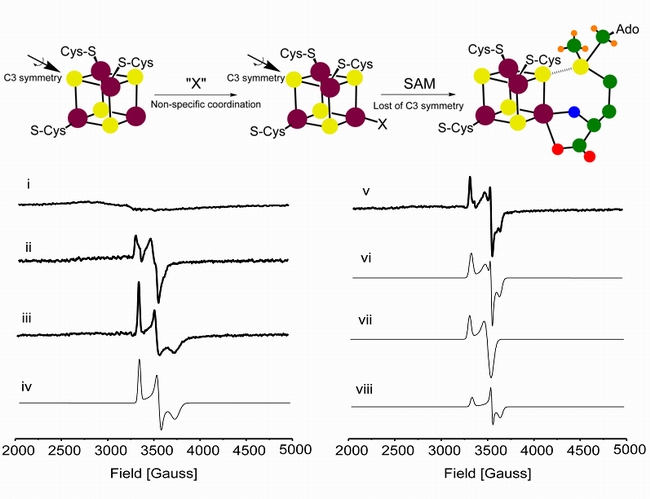May 29,2012|By
A remarkable series of studies were performed by Qi Zhang, Wen Liu and their colleagues from Shanghai Institute of Organic Chemistry, Chinese Academy of Sciences, which revealed the intriguing catalyses of two unusual radical S-adenosylmethinone (SAM) enzymes NosL and NocL.
Fe-S clusters are ubiquitous and ancient prosthetic groups that are essential for a wide range of biological processes. Besides the most prominent function of mediating electron transfer, Fe-S cluster also directly interact with the substrates to promote various enzymatically redox or nonredox reactions. Due to their wide prevalence and tremendous importance in biochemistry, great efforts have been made in studying the function of Fe-S clusters.
Qi Zhang, Wen Liu and their colleagues reported the mechanistic study of a radical SAM protein NosL (Nat. Chem. Biol. 7, 154, 2011). This protein utilizes a [4Fe-4S] cluster to reductively cleave the sulfur-carbon bond of SAM, yielding a 5'-deoxyadenosyl radical which initiate the unusual conversion of L-tryptophan to 3-methyl-2-indolic acid. The unusual and complex catalysis of NosL demonstrates the versatility and sophistication of radical biochemistry, and this work was highlighted in many important journals (Science. 331, 1366 ; Nat. Chem. Biol. 7, 133; Faculty 1000, F1000.com/8771961. FFa=10, Exceptional).
Collaborating with Shanghai Institute of Applied Physics, Chinese Academy of Sciences, the authors recently reported the study of a NosL homolog NocL. Detailed spectroscopic analyses demonstrated the interaction between L-Trp and the [4Fe-4S] cluster of NocL, revealing the heterogeneity in the [4Fe-4S] cluster of NocL in the absence of SAM. Their finding enriched the current knowledge of Fe-S clusters, and may facilitate future efforts in designing molecular probes or inhibitors for the Fe-S cluster-containing enzymes. In addition, they have firstly revealed a free, non-protein-bound glycyl radical during the NocL catalysis . This work was published as a research article in Journal of Biological Chemistry (J. Biol. Chem. 286: 30245-30252, 2011).
Collaborating with Shanghai Institute of Applied Physics, Chinese Academy of Sciences, the authors recently reported the study of a NosL homolog NocL. Detailed spectroscopic analyses demonstrated the interaction between L-Trp and the [4Fe-4S] cluster of NocL, revealing the heterogeneity in the [4Fe-4S] cluster of NocL in the absence of SAM. Their finding enriched the current knowledge of Fe-S clusters, and may facilitate future efforts in designing molecular probes or inhibitors for the Fe-S cluster-containing enzymes. In addition, they have firstly revealed a free, non-protein-bound glycyl radical during the NocL catalysis . This work was published as a research article in Journal of Biological Chemistry (J. Biol. Chem. 286: 30245-30252, 2011).


Attachments Download: